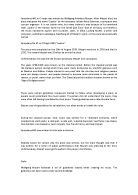Mozart Symphony No. 41 in C, K551 "Jupiter" Analysis of Development and Recapitulation
Mozart Symphony No. 41 in C, K551 “Jupiter” Analysis of Development and Recapitulation
Development
First Development
The first development starts in the key of E flat major, piano dynamic markings, with woodwind playing a short passage, which then leads into the closing theme from the exposition which is played by the strings. An inverted pedal played by flutes and oboes plays on top while the closing theme continues, when it is then passed over onto the oboes and bassoons in bar 131. From bar 133 onwards starts a thematic development, as the piece goes through several different keys. The woodwind have taken the fanfare from bar 9 (brass do not play), and are using it as a counter-melody, to aid the harmonic changes the piece is going through. The first subject taken for thematic development is taken from the end of the exposition, bar 108 in the violins. Here the theme is passed around between the strings, creating a rising sequence, while the harmony changes underneath, starting in E flat major, going from the dominant 7th, to the tonic 1st inversion, back to the dominant 7th first inversion, then the tonic. The cycle then starts again, but now in F minor, at beat 3 of bar 135, then beat 3 of bar 137 in G minor. In bar 139 the rising sequences start to descend in F minor, while the woodwind start to play longer notes, abandoning the fanfare and playing mostly thirds in the key, passing through E flat major again in bar 143.







